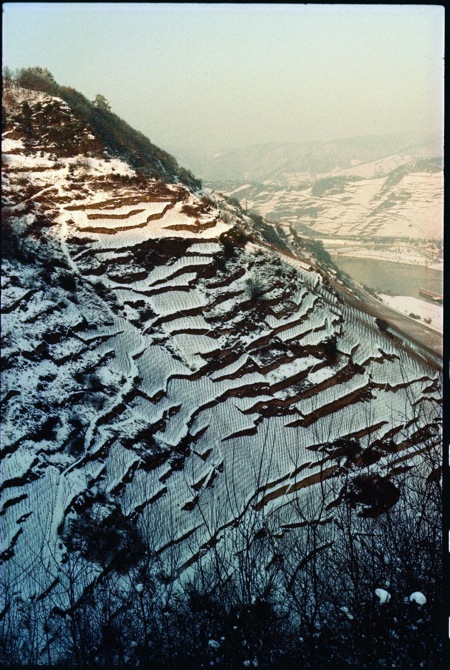- January 30, 2013
Palmberg
- by Lars Carlberg
 Further downstream and across from St. Aldegund’s old church, the idyllic Palmberg-Terrassen—the heart of the Stein family estate—has predominantly stony blue-gray slate on steep terraces with a hill country spring running below. (“Palm” is patois for Buchsbaum, boxwood, a shrub prevalent around the Mediterranean that also grows on Palmberg’s hilltop.) The 40- to 100-year-old vines have good water reserves, an even more important factor of global warming. Moreover, the south-facing site is protected from the northerly and easterly winds.
Further downstream and across from St. Aldegund’s old church, the idyllic Palmberg-Terrassen—the heart of the Stein family estate—has predominantly stony blue-gray slate on steep terraces with a hill country spring running below. (“Palm” is patois for Buchsbaum, boxwood, a shrub prevalent around the Mediterranean that also grows on Palmberg’s hilltop.) The 40- to 100-year-old vines have good water reserves, an even more important factor of global warming. Moreover, the south-facing site is protected from the northerly and easterly winds.
After the Second World War, the Stein brothers’ father, Erst Heinrich, realized Palmberg’s potential and re-cultivated what had become largely wild terrain. He still goes in the vineyard, which includes a mini-terraced shrine and, behind a shed nearby, a secret hiding place in the ground to keep bottles of Palmberg Riesling readily chilled for drinking. Erst continues to consume a bottle a day at his ripe old age.
The original Aldegunder Palmberg—no “St.” or “-Terrassen” (terraces) attached to the name—was a much smaller site. Ulli Stein gives his thoughts on this matter:
Among other things, the 1971 Wine Law destroyed both the diversity of single vineyards and their historic individuality, cultivated for centuries. The merging of smaller sites into larger [single] vineyards [Einzellagen] was supposed to simplify things for the “consumer.” Instead, it served the large bulk producers [Grosskellereien], which could buy more wine from one (presumably more familiar) expanded site and could use the best site names also for flatland vineyards now legally incorporated under that name. Palmberg-Terrassen was similarly enlarged, but included only steep slate slopes and the damage was not nearly as bad as elsewhere.
Since the 1971 Wine Law, St. Aldegunder Palmberg-Terrassen incorporates three named sections of the hillside:
Palmberg. The western and main part of the steep slope, south facing. A few sections of Palmberg (sometimes also spelled Palmesberg) , especially the western edge and highest terraces, have been overgrown with shrubs since the 1960s.
Hötlay. The impressive terraced Kuppe, or knoll, jutting out east of Palmberg; also south facing.
Rosenberg. An east-facing section around the bend. Ulli doesn’t consider this area to be a part of today’s Palmberg-Terrassen. (Almost 95 percent lies fallow today.)
Formerly, the three sites totaled around 20 hectares, only 4 ha of which are now planted with vines. Of these remaining 4 ha, 1 ha is in the “original” Palmberg and 3 ha in Hötlay. The Steins have sole ownership of the original Palmberg and own 0.3 ha and rent another 0.5 ha in the former Hötlay, meaning that their 1.8 total hectares represent 45 percent ownership of the post-1971 Palmberg-Terrassen. ♦
Photograph courtesy of Ulli Stein.
- Posted in Articles, Vineyards
- | Tagged: St. Aldegunder Palmberg-Terrassen, Stein


